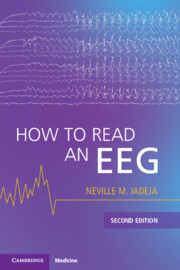Book contents
- How to Read an EEG
- Reviews
- How to Read an EEG
- Copyright page
- Dedication
- Contents
- Figure Contributions
- Foreword to the First Edition
- Preface
- How to Read This Book
- Part I Basics
- Part II Interpretation
- Chapter 7 Approach to EEG Reading
- Chapter 8 Describing Abnormalities
- Chapter 9 Artifacts
- Chapter 10 Normal Variants
- Chapter 11 Sporadic Abnormalities
- Chapter 12 Repetitive Abnormalities
- Chapter 13 Ictal Patterns (Electrographic Seizures)
- Chapter 14 Activation Procedures
- Part III Specific Conditions
- Appendix: How to Write a Report
- Index
- References
Chapter 9 - Artifacts
from Part II - Interpretation
Published online by Cambridge University Press: 27 September 2025
- How to Read an EEG
- Reviews
- How to Read an EEG
- Copyright page
- Dedication
- Contents
- Figure Contributions
- Foreword to the First Edition
- Preface
- How to Read This Book
- Part I Basics
- Part II Interpretation
- Chapter 7 Approach to EEG Reading
- Chapter 8 Describing Abnormalities
- Chapter 9 Artifacts
- Chapter 10 Normal Variants
- Chapter 11 Sporadic Abnormalities
- Chapter 12 Repetitive Abnormalities
- Chapter 13 Ictal Patterns (Electrographic Seizures)
- Chapter 14 Activation Procedures
- Part III Specific Conditions
- Appendix: How to Write a Report
- Index
- References
Summary
Artifacts are noncerebral waveforms that may mimic or obscure cerebral activity. External (nonphysiologic artifacts) are produced outside the body whereas internal (physiologic artifacts) are produced by body organs other than the brain. Electrode artifact may have a spiky, periodic, or rhythmic appearance. Characteristically, it is limited to the involved electrode with no field. Sweat artifact may involve multiple. Eye movement and glossopharyngeal artifact may mimic frontal rhythms. EKG artifact (corresponding with QRS complexes) may be confused with periodic discharges. Ventilatory artifact may be confused with bursts of cerebral activity. Characteristically, it corresponds to the respiratory rate. Head tremor presents as occipital predominant rhythmic artifact. Maneuvers and devices such as bed-percussion, continuous renal replacement therapy, and extracorporeal membrane oxygenation, CPR, and even brushing teeth may lead to ictal appearing rhythmic artifacts. Discharges associated with cortical myoclonus are best appreciated in the central channels as these are relatively free of muscle artifact. Chewing artifact may electrographically mimic a generalized tonic clonic seizure. Close observation of the patient and the surrounding equipment either in person or on video is the key to diagnosing the cause of an artifact and avoid misdiagnosing it as cerebral activity. [191 words/1168 characters]
Information
- Type
- Chapter
- Information
- How to Read an EEG , pp. 95 - 119Publisher: Cambridge University PressPrint publication year: 2025
References
Accessibility standard: WCAG 2.2 AAA
Why this information is here
This section outlines the accessibility features of this content - including support for screen readers, full keyboard navigation and high-contrast display options. This may not be relevant for you.Accessibility Information
Content Navigation
Allows you to navigate directly to chapters, sections, or non‐text items through a linked table of contents, reducing the need for extensive scrolling.
Provides an interactive index, letting you go straight to where a term or subject appears in the text without manual searching.
Reading Order & Textual Equivalents
You will encounter all content (including footnotes, captions, etc.) in a clear, sequential flow, making it easier to follow with assistive tools like screen readers.
You get concise descriptions (for images, charts, or media clips), ensuring you do not miss crucial information when visual or audio elements are not accessible.
You get more than just short alt text: you have comprehensive text equivalents, transcripts, captions, or audio descriptions for substantial non‐text content, which is especially helpful for complex visuals or multimedia.
Visual Accessibility
You will still understand key ideas or prompts without relying solely on colour, which is especially helpful if you have colour vision deficiencies.
You benefit from high‐contrast text, which improves legibility if you have low vision or if you are reading in less‐than‐ideal lighting conditions.
